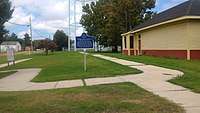Mississippi Blues Trail

The Mississippi Blues Trail was created by the Mississippi Blues Commission in 2006 to place interpretive markers at the most notable historical sites related to the birth, growth, and influence of the blues throughout (and in some cases beyond) the state of Mississippi. Within the state the trail extends from the Gulf Coast north along several highways to (among other points) Natchez, Vicksburg, Jackson, Leland, Greenwood, Clarksdale, Tunica, Grenada, Oxford, Columbus, and Meridian. The largest concentration of markers is in the Mississippi Delta but other regions of the state are also represented. Several out-of-state markers have also been erected where blues with Mississippi roots has had significance.[1]
Implementation
The list of markers and locations was developed by a panel of blues scholars and historians. The trail has been implemented in stages as funds have become available. The National Endowment for the Arts, National Endowment for the Humanities, and Mississippi Department of Transportation have provided grant for funding of various markers, which are co-sponsored with funds from local communities. The marker texts are researched and written by former Living Blues magazine editors Jim O'Neal and Scott Barretta in conjunction with an editorial and design team that has included Wanda Clark; Chrissy Wilson; Allan Hammons; and Sylvester Oliver.[2]
Prior to the founding of the Mississippi Blues Trail, two preliminary markers were placed in Indianola, Mississippi, at a corner where B.B. King played as a young man and at the Club Ebony.
The first three Mississippi Blues Trail markers were dedicated on December 11, 2006. The first, at Holly Ridge, is dedicated to Delta blues pioneer Charley Patton.[3]
The second marker is located in front of the Southern Whispers Restaurant on Nelson Street in Greenville. Nelson Street, the home of many nightclubs, cafes, and juke joints over the years, was once the primary center of African American business, entertainment, and social life in the Delta.[4] For many decades this historic strip drew crowds to the flourishing club scene to hear Delta blues; big band; jump blues; rhythm & blues; and jazz.
The third marker ceremony was at the original location of WGRM radio station in Greenwood where B.B. King first broadcast as a gospel singer.[4]
By the end of 2016, the Mississippi Blues Trail had placed nearly 200 markers,[5] not only in honor of individual artists, clubs, record companies, radio stations, and historic events, but also in celebration of plantations, streets, cities, and counties that were centers of blues activity, as well as at Mississippi State Penitentiary at Parchman, where folklorists have recorded blues by inmates (most notably Bukka White) on several occasions dating back to the 1930s.[6]
Current markers
Locations are in Mississippi unless otherwise stated.
Source: Mississippi Blues Trail official web site
See also
References
- ↑ Widen, Larry. "JS Online: Blues trail". Jsonline.com. Archived from the original on 2007-12-15. Retrieved 2008-05-29.
- ↑ "Mississippi Blues Commission - Blues trail". Msbluestrail.org. Retrieved 2007-02-09.
- ↑ "Haley Barbour Unveils First Marker of Mississippi Blues Trail". Jazz News. Retrieved 2007-02-09.
- 1 2 "Blues Matters! - Delta sites to be included on new blues trail". Bluesmatters.com. Archived from the original on 2011-07-08. Retrieved 2008-05-28.
- ↑ "Mississippi Blues Commission - List of Blues Trail Markers". Msbluestrail.org. Retrieved 2017-04-22.
- ↑ "BLUES TRAIL MARKS PARCHMAN AS MAJOR INFLUENCE." State of Mississippi. September 23, 2010. Retrieved on October 3, 2010.
- ↑ "Mississippi honors Houston's Texas Johnny Brown - Houston Chronicle". Chron.com. 2011-09-01. Retrieved 2013-07-06.
External links
| Wikimedia Commons has media related to Mississippi Blues Trail. |
- Mississippi Blues Trail list and map
- Delta Blues in the Lower Mississippi Valley, Indianola
- Mississippi Blues Highway Registry











